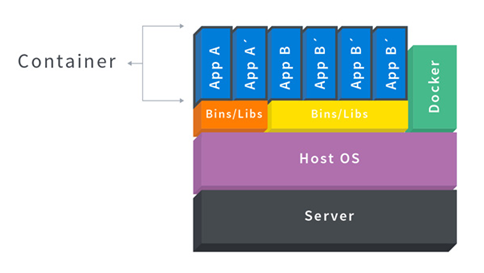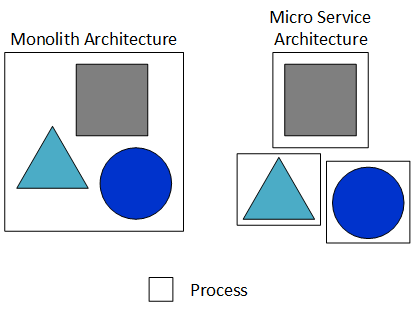| Term | Definition |
|---|---|
| Agnostic | |
| API | See Application Programming Interface |
| Application Programming Interface | |
| CEP | Complex Event Processing |
| Cloud | |
| Container | Containers are virtual environments for deploying software applications that are isolated from each other but may share Operating Sytems, binaries, and libraries. Virtual machines or virtual systems have their own set of resources allocated to them, but containers do not. Therefore, Containers are lighter weight virtual environments but with less isolation. Containers are often adopted by microservice applications where each microservice runs in its own container. _________ can currently be deployed in Docker containers and Snappy containers. |
| Created time stamp | The Created time stamp is the time the data was created in the database and is unchangeable. The Origin time stamp is the time the data is created on the device, device services, sensor, or object that collected the data before the data was sent to ____ and the database. Usually, the Origin and Created time stamps are the same, or very close to being the same. On occasion the sensor may be a long way from the gateway or even in a different time zone, and the Origin and Created time stamps may be quite different. |
| DELETE | |
| Docker | The name of ___________ |
| GET | |
| HW | Hardware |
| IoT | Internet of Things |
| IIoT | Industrial Internet of Things |
| Java | |
| Meta data | |
| Microservices | Iindependently developed, deployed, and updated software application components. Individual microservices rarely satisfy an end user's requirements, but collectively a collection of micr services form an application or system do meet the user's needs. Micro services make it easier to change and add functionality to a system. |
| MQTT | |
| MSA | See Microservice Architecture |
| Nanoservice | Smaller segment than a microservice. Very fine-grained service where the service's overhead outweighs its utility. __________ uses microservices and does NOT use nanoservices. |
| North Side | |
| Origin time stamp | The Origin time stamp is the time the data is created on the device, device services, sensor, or object that collected the data before the data is sent to ____ and the database. The Created time stamp is the time the data was created in the database. Usually, the Origin and Created time stamps are the same or very close to the same. On occasion the sensor may be a long way from the gateway or even in a different time zone, and the Origin and Created time stamps may be quite different. |
| PaaS | See Platform as a Service |
| Platform as a Service | A cloud-based environment in which to develop, run, test, and maintain web-based applications. The PaaS environment provides the entire IT resource stack as a service and provides all of the facilities required to support the complete life cycle of building and delivering web-based applications. Using PaaS enables the creation and deployment of web-based application software without the cost and complexity of buying and managing underlying hardware, operating software, and utilities. Using PaaS therefore enables Developers to accelerate the pace of developing applications while reducing the complexity because Developers can provision, deploy, and manage applications using one unified management system. By using PaaS, Developers get their application to market faster, and can innovate and experiment with new technologies using existing public, private, or hybrid cloud infrastructures. |
| PLC | Programmable Logic Controller |
Polyglot | An application or system written in multiple programming languages and/or using multiple application development frameworks and tools. _________ is a polyglot system because each of the microsystems are written in different programming languages, using many different tools and technologies. To date, __________ microservices are written in Java, Python, Node.js (JavaScript), and Go. |
| POST | |
| PUT | |
| REST | short for RESTful |
| RESTful | Representational State Transfer, or RESTful web services. Use REST with ________. |
| Rules Engine | And why is a rules engine important to IoT edge systems? A rules engine is a software system that is connected to a collection of data (either database or data stream). The rules engine examines various elements of the data and monitors the date, and then triggers some action based on the results of the monitoring of the data it. Basically, a rules engine is a collection of "If-Then" conditional statements. The "If" informs the rules engine what data to look at and what ranges or values of data must match in order to trigger the "Then" part of the statement, which then informs the rules engine what action to take or what external resource to call on, when the data is a match to the "If" statement. Most rules engines can be dynamically programmed meaning that new "If-Then" statements or rules can be provided while the engine is running. The rules are often defined by some type of rule language with simple syntax to enable non-Developers to provide the new rules. Rules engines are one of the simplest forms of "edge analytics" provided in IoT systems. Rules engines enable data picked up by IoT sensors to be monitored and acted upon (actuated). Typically the actuation is accomplished on another IoT device or sensor. For example, a temperature sensor in an equipment enclosure may be monitored by a rules engine to detect when the temperature is getting too warm (or too cold) for safe or optimum operation of the equipment. The rules engine, upon detecting temperatures outside of the acceptable range, shuts off the equipment in the enclosure. |
| SaaS | See Software as a Service |
| SDK | See Software Development Kit |
| Service-Oriented Architecture | |
| Snappy | The name of ____________ |
| SOA | See Service-Oriented Architecture |
| Software as a Service | |
| Software Development Kit | |
| South Side | |
| SW | Software |
| UI | User Interface |
Overview
Content Tools

